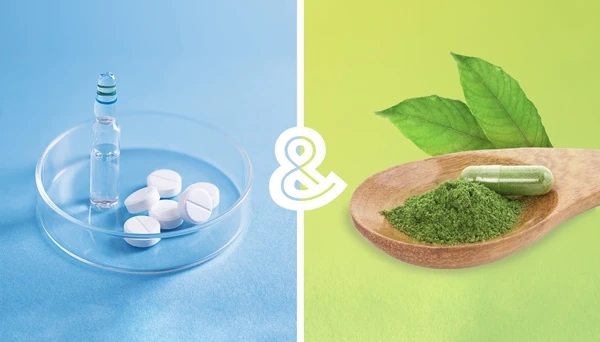Kratom & Tramadol: A Dangerous Combination
If you enjoy kratom, it’s in your best interest to know how it interacts with opioid medications such as tramadol.
Kratom is an all-natural substance, but it interacts with the same receptors as pharmaceutical opioids, which can have profound implications.
This guide will fill you in on everything you need to know about mixing kratom and tramadol.
Does Kratom Interact With Tramadol?
Yes, kratom and tramadol are very likely to interact — potentially leading to life-threatening side effects.
Firstly, tramadol and kratom both activate opioid receptors, decreasing the amount needed to overdose.
Kratom and tramadol also compete for liver metabolism. Taking them together can slow the elimination of both substances, leading to a higher chance of side effects. This issue is compounded with repeated doses.
The metabolization of kratom and tramadol is primarily through the CYP2D6 enzyme.
Mixing tramadol and kratom leads to increased blood plasma levels of tramadol and puts the user at a heightened risk of severe adverse effects.
Is it Safe to Take Kratom With Tramadol?
No, this combination should be avoided.
In general, mixing kratom with any other opiate-like substance is not recommended.
No drug is 100% harmless, but, by itself, kratom is remarkably safe. Many people turn to kratom instead of opiate painkillers for this reason.
What is Tramadol?
Tramadol is a synthetic opioid analgesic. It’s available only through prescription and is a Schedule IV drug in the Controlled Substances Act. This designation entails the drug has accepted medical uses and a low potential for abuse and dependence. In this sense, it is considered less dangerous than other opioid medications like diamorphine or methadone.
Tramadol exists in both instant-release and extended-release formulations; it is also available by injection.
Tramadol works on the body’s μ-opioid receptors, and it’s also a serotonin-norepinephrine reuptake inhibitor (SNRI), which means it has anti-depressant qualities.
In 2019, tramadol was the 35th most commonly prescribed medication in the United States
Tramadol Specs:
Drug NameTramadolTrade NameUltramClassificationOpioidCYP MetabolismPrimarily metabolized by CYP3A4Interaction With KratomAgonistic relationship & kratom will inhibit the proper metabolization of tramadol.Risk of InteractionHighWhat is Tramadol Used for?
The FDA has approved tramadol to manage moderate to severe chronic pain in adults who require around-the-clock treatment for an extended period.
Because of the inherent risks of addiction and misuse, the FDA recommends tramadol only in instances where non-opioid analgesics have not been tolerated or have not been able to provide adequate analgesia.
Because it’s an SNRI, research suggests that tramadol is effective as an anti-depressant. However, this is an off-label usage since it has not been approved for this purpose.
Lastly, another suggested off-label use for tramadol is the second-line treatment of fibromyalgia.
What’s the Dose of Tramadol?
Since tramadol is a prescription-only drug, the precise dosage regimen of a user should always be handled by a physician. Do not attempt to deviate from your doctor’s dosage recommendations.
As a general guideline, the FDA recommends that users utilize the lowest effective dosage for the shortest duration consistent with individual patient treatment goals.
Unless the user is in acute pain and needs considerable analgesic relief, the dosage recommendations for tramadol usually involve starting on a low dose and then incrementally increasing until the effective dosage is achieved.
Generic & Brand Name Versions
Tramadol is available under the following brand names:
UltramZytramQdoloRyzoltConZipWhat Are the Side Effects of Tramadol?
In a similar fashion to other opiate medications, the most common side effects of tramadol are: nausea, dizziness, constipation, vomiting, drowsiness, and headaches. More serious adverse effects include: seizures, suicidal ideation, serotonin syndrome, anaphylactic and allergic reactions, and respiratory depression.
There are also several contraindications for tramadol:
Pregnancy and lactationLabor and deliverySevere renal and hepatic impairmentPeople under 18Patient with bronchial asthmaConcomitant use with other CNS depressantsConcomitant use with CYP2D6 and 3A4 inhibitors.Finally, note that tramadol does have the capability to cause physical and mental dependence, as well as withdrawal symptoms.
What is Kratom?
The kratom plant (Mitragyna speciosa) is a tropical evergreen tree native to Southeast Asia. It’s been used there for centuries by the indigenous peoples for many health benefits.
Kratom has a whole suite of psychoactive properties that derive from the potent alkaloids contained within it.
Despite FDA meddling, the kratom community in the United States is going strong. This incredible compound has already helped improve the lives of thousands of people.
Kratom does indeed have its dangers (as basically all drugs do), but with proper care and responsibility, kratom is widely regarded as safe to consume.
People also read: What is Kratom, And Why Do Lawmakers Want To Regulate It?What is Kratom Used for?
Even though scientific research on kratom is minimal, some studies back up many of its traditional uses.
Here are some common uses for kratom:
Boost energy and focusEnhance moodPain reliefRelieve anxiety and depressionOpiate withdrawalBetter sleepKratom’s uses seem to extend beyond this and might help with weight loss or improve one’s sex life.
It promotes sleep and can effectively lessen opioid withdrawal symptoms (under the supervision of a doctor).
What’s the Dose of Kratom?
Kratom dosage can get tricky because as the dose increases, the effects of kratom will start to shift into new properties. This is why kratom has such a vast number of benefits!
A low dose (2-4 g) will make kratom act like a stimulant, similar to coffee or the coca plant. Users will feel energized and have increased concentration; it even provides mood-boosting effects.However, once we start getting into higher doses (4-8 g), the effects of kratom start becoming more analgesic and anxiolytic — perfect for those suffering from anxiety or chronic pain!Large doses of kratom (8-12 g) will increase the intensity of the former effects and will provide sedative and tranquilizing benefits.For a more in-depth explanation, check out our general dosing guidelines.
People also read: Buying Kratom? A Kratom dosage & Kratom effects primerWhat Are the Side Effects of Kratom?
Kratom is safe but does have a few side effects, though these usually come in higher doses.
The most common side effects of kratom may include:
Anxiety or nervousnessConstipationDizzinessInsomniaNauseaSevere adverse effects of kratom may include:
ItchinessLoss of muscle coordinationLow blood pressureLow libidoNauseaPoor appetiteSeizuresTremorsKratom deaths are incredibly rare. Far more dangerous drugs like cocaine and heroin are present in almost all instances.
What Are the Different Types of Kratom?
Kratom comes in four main strains: white, red, green, and yellow.
You should become familiar with these strains because they all excel at promoting different areas of the kratom spectrum.
A) White Vein Kratom
White vein kratom is best at simulating the effects of a low dose of kratom. This would be the stimulant side of the spectrum: expect potent boosts in energy and focus and an enhanced mood.
If your morning coffee isn’t getting the job done, go with a white-veined kratom strain!
B) Red Vein Kratom
Red vein kratom will help users experience the analgesic and anxiolytic aspects of the kratom spectrum.
Red-veined kratom strains are incredibly popular with those looking to replace pharmacological painkillers and anti-depressants. The kratom community is filled with stories of people who’ve made the jump and are much happier for it.
C) Green Vein Kratom
Green vein kratom is sort of the in-between of white and red. Instead of providing a targeted experience, it will give the users a nice and balanced ride.
If you want to try out all of the elements of the kratom spectrum equally, then definitely go with green.
D) Yellow Vein Kratom
Yellow-vein kratom is like green but less potent — perfect for first-timers or those who have tried kratom and found that they have a sensitivity to it.
Key Takeaways: Is it Safe to Mix Kratom & Tramadol?
No, kratom and tramadol should not be mixed for any reason.
These drugs have too much overlap in how they work, and tramadol carries too high a risk for side effects — many of which can cause a life-threatening injury. Taking kratom and tramadol carries a high risk of overdose.
If, for some reason, you feel like you must take both tramadol and kratom, then we suggest you contact your doctor and explore what other options are available for you.
Read more: Kratom & Tramadol: A Dangerous Combination


